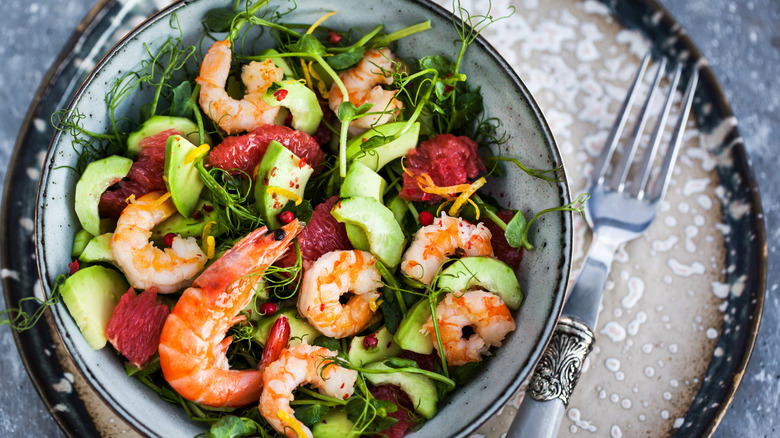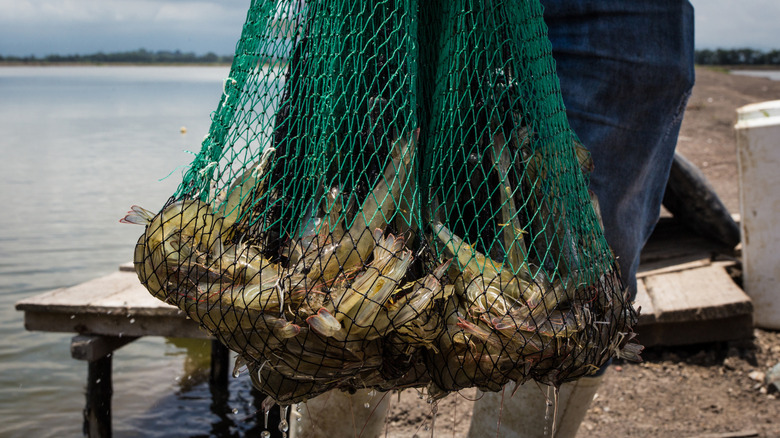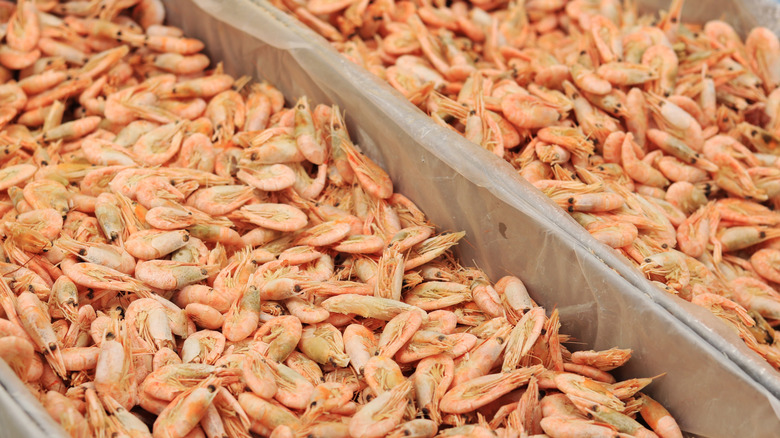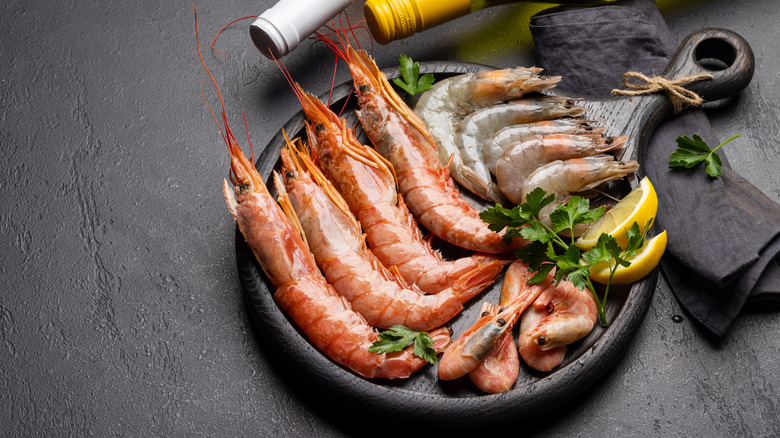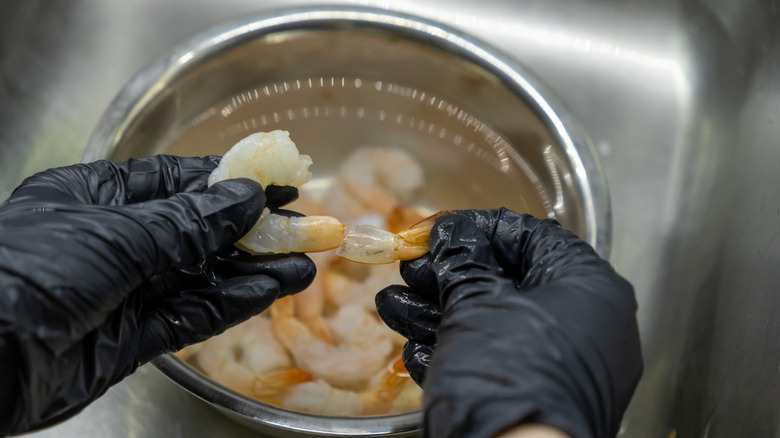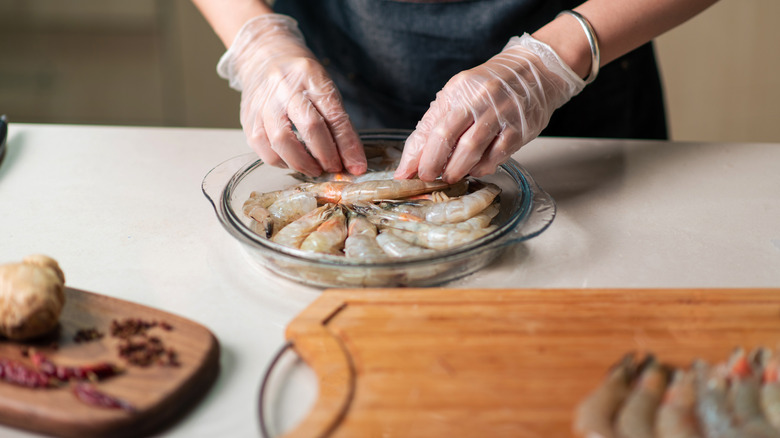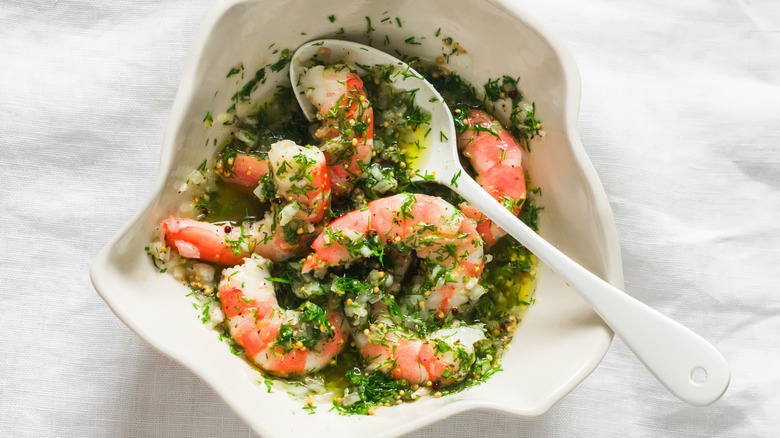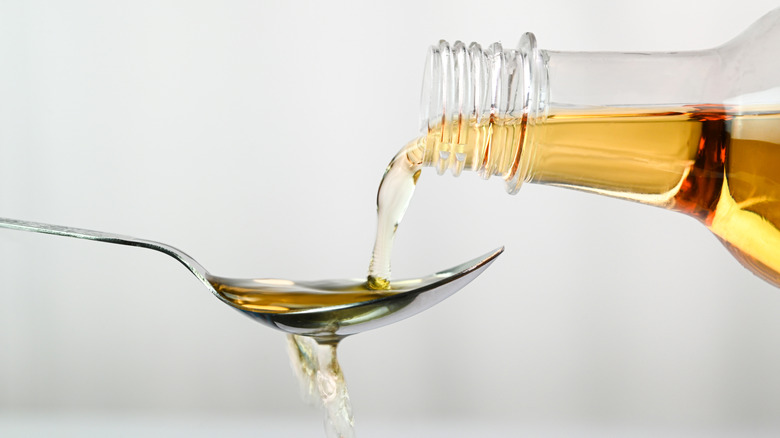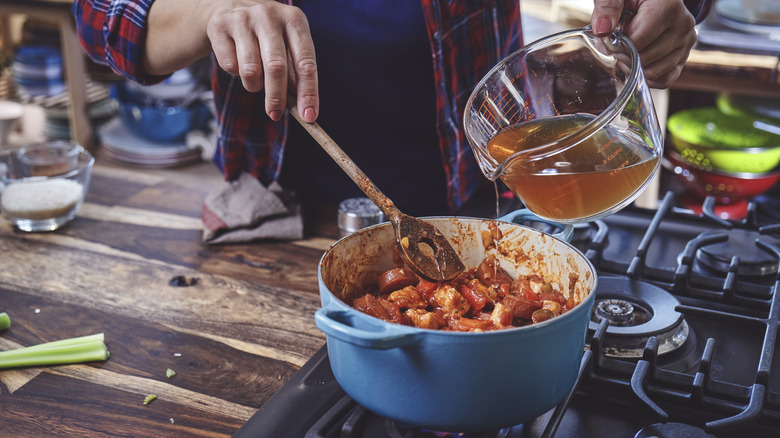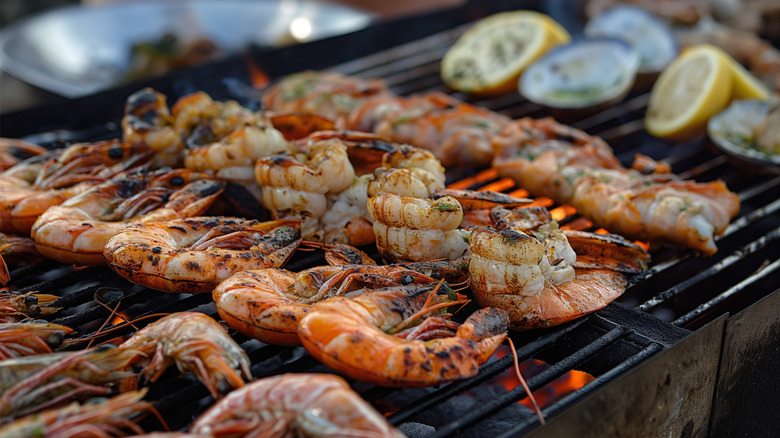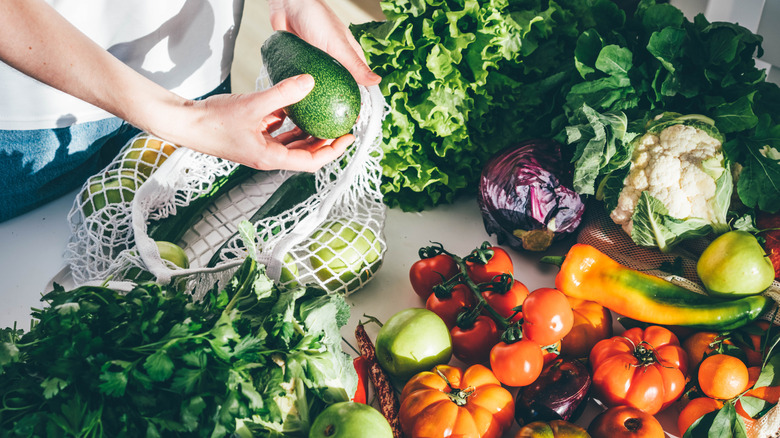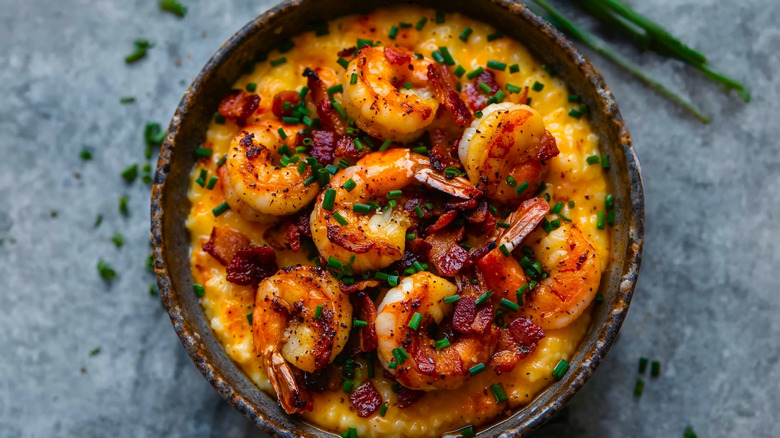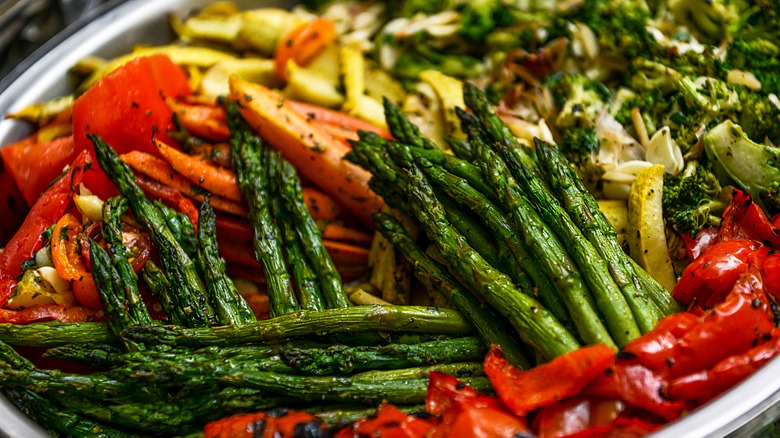Why Shrimp Always Taste Better At A Restaurant
When your steaming plate of fried shrimp or butter-soaked bowl of shrimp scampi works its way over to your table at your favorite restaurant, your mouth probably starts to water in anticipation. And for good reason — these delicious shrimp dishes are prepared to perfection, making them memorable and highly sought-after meals showcasing the United States' most popular seafood.
While the dish may seem effortlessly delicious as it's set down in front of you, creating a masterful shrimp dish takes a lot of thought, preparation, and planning — all which happens at a restaurant before you even sit down to dine. Chefs spend years honing their craft, learning tricks of the trade, and experimenting with new techniques that result in these delectable shrimp dishes. So it's only natural that home cooks may be wondering, "How can I recreate my favorite restaurant-quality shrimp meals?"
We spoke with experts to learn some of the insider secrets restaurants use in their kitchens to make shrimp taste so delicious. They lend advice on how home chefs can achieve the same taste and quality in the comfort of their own kitchens. Read on to discover their top recommendations to achieve restaurant quality and learn how to elevate your favorite shrimp dishes to a whole new level.
Restaurants use the freshest product
When it comes to shrimp — and seafood in general — choosing the best, freshest ingredients is often what sets a dish apart in both flavor and texture. Restaurants have industry connections and suppliers that allow them to source high quality, local shrimp that gives their meals a leg up on at-home concoctions.
"There's nothing quite like shrimp that's been caught straight out of the Gulf of Mexico," explained Craig Norman, general manager of Pensacola, Florida's restaurant Red Fish Blue Fish. While the majority of wild shrimp in the U.S. is sourced from the Gulf, it is also fished along the southeastern coast in the Carolinas. When shopping for fresh shrimp, be sure to look for a few key characteristics, according to registered dietician and blogger at Dish on Fish, Rima Kleiner. It should have a firm texture, a mild saltwater smell, and intact tails. Be sure to avoid any shrimp that seems soft or slimy, or has a strong, ammonia-like odor, which can signal the shrimp has gone bad.
Paying close attention to the quality of your star ingredients will help ensure your final dish is as delicious as possible — and really allow your shrimp to shine. For those who don't live near a coastal locale, you can also opt for frozen shrimp. This is typically flash-frozen shortly after it's caught, maintaining the freshness and locking in the delicious flavor.
Pro chefs know how to choose the right size of shrimp
Shrimp comes in many different shapes and sizes, and choosing the right one can make or break a dish. While large shrimp sizes like super colossal are perfect for raw bar preparations like shrimp cocktail, smaller shrimp are ideal for dishes like tacos or seafood soups and stews. There are also jumbo, large, and medium varieties, so there is a shrimp size well-suited for any recipe.
Professional chefs in restaurant kitchens are well-versed in the different types of shrimp and which sizes are the best fit for which dishes. To make your meals feel like a pro prepared them at home, familiarize yourself with the different shrimp sizes so you know which one is best for any given dish. At the supermarket, you'll often be able to identify the size by determining how many shrimp are in a 1 pound bag; the fewer the shrimp per pound, the larger the size.
Just remember that the larger the shrimp, the longer it takes to cook. If you're cooking from a recipe, be sure to account for any differences in shrimp size between what's recommended and what you've purchased to make sure everything is cooked thoroughly.
Restaurateurs understand the different varieties of shrimp
While all shrimp may look the same to the untrained eye, there are many different varieties. Each has its own pros, cons, and flavors, and chefs know exactly which type to choose to best complement the dish they're preparing to take it to the next level.
White shrimp is one of the most common varieties, and is fished along the entire eastern seaboard of the United States from New York to Florida and along the Gulf coast. It can easily be found fresh or frozen in the grocery store and is a popular variety thanks to its sweet, mild flavor. White shrimp also quickly absorb flavors, making them perfect for marinating or using in dishes with plenty of sauce.
Another common option is pink shrimp, which is found in the warmer waters off the coast of Florida down to Mexico's Yucatan Peninsula. This large variety gets its name from its light pink color when raw. This sweet, tender variety is extra meaty, making it ideal for things like raw bar or shrimp boils.
Brown shrimp, rock shrimp, and tiger shrimp are all other widely available options, too. Curious home chefs can try incorporating these different varieties in their dishes to give the final product a more elevated, unexpected flavor.
Chefs make sure to devein the shrimp
There is one pivotal prep step that should never be skipped. The process of deveining shrimp requires removing the thin, dark line that runs along the shrimp's back. Though called a vein, it's actually the shrimp's digestive tract — and while not necessary to remove, taking this extra step can help prevent grittiness that impacts the shrimp's flavor and texture. Though shrimp are often already sold deveined, if necessary, it's a simple process that can be easily completed in the restaurant kitchen or in the comfort of your own home.
"[It] can be done easily with a specialty tool or a simple paring knife," explained Rima Kleiner. "Gently slice down the center of the shrimp's back, then pull the vein out with the tip of your knife or toothpick. For a smoother process, especially with smaller shrimp, consider asking your fish vendor to devein them for you." Once the shrimp has been deveined, you can continue on with the rest of your prep steps to get your shrimp ready to eat.
Restaurants prioritize proper prep
Achieving a restaurant-quality shrimp dish largely comes down to one thing: proper ingredient prep. Without taking the time to ensure the shrimp are properly cleaned, dried, and seasoned, a dish will undoubtedly fall flat.
In addition to deveining, there are a few other important steps before cooking your shrimp. "Allow the shrimp to come to room temperature for about 10-15 minutes before cooking to help ensure even cooking," Rima Kleiner said. Once the shrimp comes to room temperature, shell the shrimp and remove the head if necessary (though many shrimp are sold already shelled). You can also remove the tail if preferred to avoid the hassle of removing it while eating. Patting the shrimp dry will also help you get a nice, brown sear on the shrimp; be sure to pat it dry before cooking, especially if the shrimp was thawed from frozen and has a lot of excess moisture.
To keep shrimp moist and to lock in flavor, you can also employ a restaurant trick of the trade: the dry brine. A mix of salt and baking soda will help keep shrimp moist while encouraging a nice crunch, offering the best of both worlds. Add the raw shrimp to your mixture about an hour before cooking to reap the benefits.
Food-industry professionals marinate shrimp for extra flavor
"While shrimp is delicious with just a drizzle of oil or butter, lemon juice, and fresh herbs, using a marinade can enhance the flavor," explained Rima Kleiner. Choosing the right marinade can totally transform the feel of your dish, infusing the seafood with different flavors to suit your preferred palate or the style of your dish. Dried herbs, spices, aromatics, and condiments like mustard or even fermented Korean chile paste gojuchang will complement the sweet, mild flavor of shrimp for nearly endless possibilities.
For something Mediterranean-inspired, a marinade might include olive oil and herbs like dill, fennel, and cumin. A Cajun dish, on the other hand, may have onion and garlic powders, paprika, black pepper, and cayenne. A cilantro-lime combination is also a delicious option that makes shrimp perfect for Mexican-inspired meals like tacos or fajitas.
While the rule of thumb for many meats and seafood is the longer the marinating time the better, shrimp is the exception to this rule. If you're trying to recreate a restaurant-quality dish at home, opt to only marinate the shrimp for about half an hour. Any longer can compromise the shrimp's texture and lead to an unappetizing final product.
Chefs avoid adding excessive acid
Though the versatility of shrimp marinades is infinite, there's one primary ingredient you should almost always avoid: acid. "If you choose a marinade that contains an acid like vinegar or lemon, lime, or orange juice, marinate for 30 minutes or less in the refrigerator. Acid breaks down the proteins in shrimp, which can make the shrimp tougher if in vinegar or citrus juice for too long," said Rima Kleiner.
These acids will denature the protein in the shrimp, causing the seafood to essentially cook without using any heat. And while this can be used to your advantage when purposefully employed to make dishes like ceviche, the denatured proteins otherwise can result in an unappealing, mushy texture.
If you choose to include any of these ultra-acidic ingredients in a marinade, use them sparingly to preserve the tenderness and sweet taste of freshly caught shrimp. Another restaurant kitchen tip? Try incorporating acid into your dish in other ways — like with an acidic vinaigrette on a side salad, a citrus sauce, or a squeeze of lime on top of your finished dish — to incorporate your preferred flavors without sacrificing the shrimp's textural integrity.
Restaurants avoid overcooking shrimp
It may be tempting to toss shrimp onto a hot pan and sauté it up almost instantly, but in restaurant kitchens, they prefer to take their time to deliver the luscious, tender texture of shrimp everyone knows and loves. Heating the shrimp slowly is pivotal to preserving that tenderness, so patience is key. "While boiling [shrimp] typically takes around five minutes, slowly raising the temperature of the water leads to a more tender texture. By allowing the shrimp to cook more gradually, you reduce the risk of overcooking," explained Rima Kleiner.
The length of time the shrimp cooks also depends on its size. "A good rule of thumb to keep in mind is to cook medium shrimp for about three minutes, large shrimp for about five minutes, and jumbo shrimp for about seven minutes," she added. "Regardless of the cooking method, look for a color transition from blue to red-pink and watch for the meat to turn opaque before removing from [the] heat." These indicators will help you know when to pull the shrimp from the heat for the perfect level of doneness — and avoid the dreaded rubbery texture that is a result of shrimp cooking for too long.
Chefs try multiple cooking methods
Shrimp is endlessly versatile, making it the perfect protein for a variety of dishes from pasta to po'boys. And while it's easy to focus on a single preparation like sautéing for example, cooking shrimp in a variety of ways helps restaurants diversify their menus and also bring out different flavors and textures in this crowd-favorite seafood. Sautéing, grilling, or boiling shrimp are all options to enhance the flavor of the seafood and achieve a perfect texture, according to Rima Kleiner. Craig Norman also recommended lightly frying the shrimp for a crisp, satisfying crunch.
A few popular options for home chefs looking to recreate a restaurant-quality dish with a lot of wow factor? Old Bay-steamed shrimp infuses the seafood with the signature Maryland spice — without a lot of time or effort — for a low stress way to deliver high-impact flavor. For something Asian-inspired, opt instead for shrimp sautéed in aromatics in this garlic shrimp and ramen recipe. You also can't beat the simplicity and flavor of boiled shrimp for a classic shrimp cocktail.
Eateries serve shrimp with bright, fresh flavors
Though shrimp holds its own against bold flavors, it's often most delicious when prepared simply with fresh and flavor-packed ingredients. "In my kitchen, I prioritize using basic yet high-quality ingredients, paired with proper cooking techniques, to bring the best out of shrimp," said Craig Norman. "Fresh lemon juice and zest add a bright acidity, while Kosher salt and coarse ground pepper enhance the flavor profile." Fats like butter or oil complement these zesty, herbaceous flavors as a final component to round out the dish.
For something a little more sophisticated that emulates restaurant preparation, home chefs can also opt to add a little white wine to their pan for a rich, layered taste. "I wholeheartedly adhere to the old culinary adage that 'seafood must swim three times' — first in water, then in butter, and finally in wine — which I find holds true for shrimp as it creates a divine combination that tantalizes the palate," he added. The perfect recipe to test this theory? Copycat Red Lobster shrimp scampi – especially since the chain has recently closed dozens of locations, making its delectable pasta dish harder to come by. Just be sure to avoid common pitfalls home chefs make when cooking with wine for the best possible final product.
Chefs utilize tried-and-true flavor pairings
Unconventional or unexpected flavor pairings can set a restaurant apart — but there's nothing compared to classic combinations that people come back to again and again. Restaurants often lean on these beloved dishes because they are not only delicious but familiar to a wide audience of diners. Shrimp dishes like gumbo, shrimp and grits, or shrimp scampi are all perfect ways to showcase beautiful, fresh seafood.
But just because a dish is tried-and-true, it doesn't mean you can't put your own twist on it. "My culinary journey in Charleston, South Carolina further enriched my appreciation for shrimp in the iconic dish of shrimp and grits accompanied by a savory Tasso gravy," said Craig Norman. "This dish has become my go-to recipe, encapsulating the essence of comfort food while offering a sophisticated palate of flavors that complements the sweetness of the shrimp beautifully."
To implement the restaurant approach in your own kitchen, take your favorite shrimp dish and come up with your own interpretation. From something simple like swapping out spices or sauces to concocting more elaborate creations, shrimp is an endlessly versatile seafood that allows you to express your creativity.
Restaurants keep side dishes simple
"As a delicate and versatile protein, shrimp pairs beautifully with a range of sides," said Craig Norman. "My favorites reflect my Southern roots. A staple in my cooking is good Southern cheese grits, infused with grated Parmesan and tangy goat cheese that enriches the dish's velvety texture."
In addition to grits, Norman also favors a diverse range of sides to pair with shrimp, showcasing the protein's versatility and wide range of delicious flavor pairings. "Pasta frequently graces my table as well, and I love complementing my shrimp dishes with fresh, local vegetables that vary with the seasons," he added.
In the spring and summer months, opt for grilled vegetables like asparagus or zucchini. (If you need inspiration, here are 21 asparagus recipes that will perfectly complement your favorite shrimp dish). Shrimp is also a popular add-on to Caesar or garden salads for those looking for a light, refreshing meal.
During the winter months, opt instead for hearty veggies like broccoli, potatoes, or cauliflower. You can also mix and match different shrimp preparations — like fried, poached, or sautéed — with diverse veggie preparations like puréed, roasted, or mashed for nearly endless combinations.
